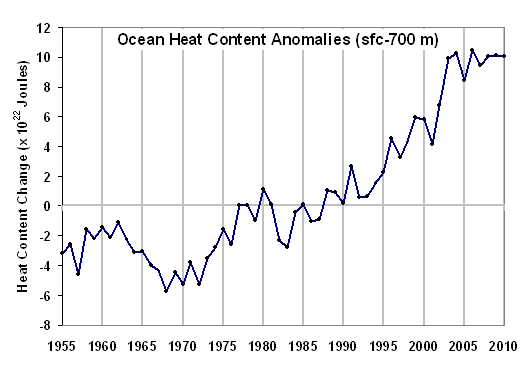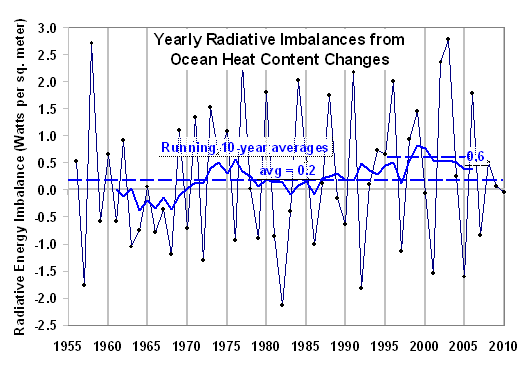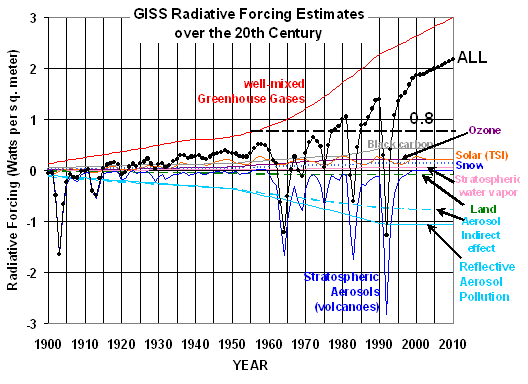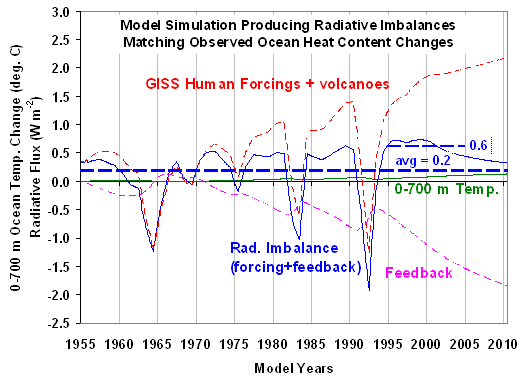UPDATE (1:20 pm. CDT 5/13/11): Since the issue of deep ocean warming (below 700 m depth) has been raised in the comments section, I have re-run the forcing-feedback model for the following two observations: 1) a net 50 year warming of 0.06 deg. C for the 0-2000 meter layer, and (2) a surface warming of 0.6 deg. C over the same period. The results suggest a net feedback parameter of 3 W m-2 K-1, which corresponds to a climate sensitivity of 1.3 deg. C from 2XCO2, which is below the 1.5 deg. C lower limit the IPCC has placed on future warming.
Weak Warming of the Oceans 1955-2010 Implies Low Climate Sensitivity
Assuming that the Levitus record of global oceanic heat content increase is anywhere near accurate, what might it tell us about climate sensitivity; e.g., how much global warming we might expect from increasing atmospheric carbon dioxide concentrations? As we will see, the oceans have not warmed nearly as much as would be expected if the climate system really is as sensitive as the IPCC claims.
The following now-familiar plot of ocean heat content change for the surface Ė 700 meter depth layer is the result of a layer average temperature increase of about 0.17 deg. C over the 55 year record:

In the meantime, global average sea surface temperatures have reportedly increased at about 3.5 times this rate, about 0.6 deg. C, based upon the HadSST2 data.
As Bob Tisdale has pointed out, the above plot expressing heat content in terms of gazillions of Joules sounds dramatic (if you didn’t know, 1022 is 1 gazillion) — but the 0.2 deg. C warming upon which it is based?…maybe not so much.
Nevertheless, what is useful about the heat content data is that it is relatively easy to then calculate from the yearly changes in ocean heat content how much of an energy imbalance (energy flow rate into the ocean) is required to achieve such changes.
This ends up being an average of 0.2 Watts per sq. meter for the 55 year period 1955-2010…a calculation that Levitus also made. Hereís what the yearly energy imbalances look like which are required to cause the yearly changes in ocean heat content:
Note that with considerable smoothing of the data, we see a peak imbalance around 0.6 W m-2 during the maximum warming rate around the year 2000.
Now, by way of comparison, how much radiative forcing does James Hansen (GISS) estimate the climate system has undergone during the same period of time? The following plot shows the various forcings Hansen has assumed:
Letís assume, for the sake of illustration, that Hansen is correct for all of these forcings. In that case, the average of the all-forcings curve over the period 1955-2010 is about 0.8 W m-2.
Now letís compare these 2 numbers for the period 1955-2010:
Average Radiative Forcing from CO2, aerosols, volcanoes: 0.8 W m-2
Average Radiative Imbalance from increasing ocean heat content: 0.2 W m-2
Assuming the ocean heat content data and Hansen’s forcing estimates are accurate, how could the average radiative forcing be 4 times the average radiative imbalance? The answer is FEEDBACK:
Radiative Imbalance = Forcing – Feedback
As the system GAINS energy (and warms) from forcing, it LOSES energy from feedbacks: e.g., changes in clouds, water vapor, and most importantly the extra loss of IR energy directly to space from warmer temperatures (which is usually not considered a feedback per se, but it is THE main climate stabilizing influence, and for purposes of discussion I will treat it as a “feedback”).
If there was no feedback (which would indicate a borderline unstable climate system), then the ocean heat content-inferred radiative imbalance (0.2 W m-2) would equal the forcing (0.8 W m-2), which it clearly doesnít since there is a 4x difference.
Of course, some believe that CO2 forcings do not even exist (although I’m not one of them). Here I am simply trying to determine what might be concluded about climate sensitivity if we assume Hansenís forcings and the OHC increases are correct. As we will see, the large difference between forcing (0.8) and radiative imbalance (0.2) implies an insensitive climate system.
Next, we can use these numbers to estimate the net feedbacks operating in the climate system. The simple time-dependent model of the climate system in this case looks like this:
Cp[dT700/dt] = Forcing Ė λTsfc
Which computes the change in temperature with time of the 700 m deep ocean layer (dT700/dt) which has a heat capacity of Cp in response to Hansenís radiative forcings and radiative feedback in response to surface temperature changes (λTsfc).
The reason why we need to use 2 temperatures is that the surface has reportedly warmed about 3.5 times faster than the 0-700 meter ocean layer does, and radiative feedback will be controlled by changes in the temperature of the sea surface and the atmosphere that is convectively coupled to it.
If we run this model, we can adjust the feedback parameter λ until we get the kinds of radiative imbalances inferred from the ocean heat content changes. The following shows what seemed to provide a reasonable match:
The feedback parameter λ used here is 4 W m-2 K-1, which implies a climate sensitivity of only 1 deg. C warming from a doubling of CO2. This is much less than the IPCCís estimate of 2.5 to 3 deg. C of warming.
In particular, note from the above model simulation how the strong feedback mostly offsets the forcing, leaving a small radiative imbalance, consistent with the large discrepancy between Hansen’s average forcing (0.8 W m-2) and the ocean heat content-inferred energy imbalance (0.2 W m-2).
The bottom line is that the ocean has not warmed nearly as much as would be expected based upon the climate sensitivities exhibited by all of the climate models tracked by the IPCC.
Now, what I do not fully understand is why the IPCC claims that the ocean heat content increases indeed ARE consistent with the climate models, despite the relatively high sensitivity of all of the IPCC models. While some might claim that it is because warming is actually occurring much deeper in the ocean than 700 m, the vertical profiles I have seen suggest warming decreases rapidly with depth, and has been negligible at a depth of 700 m.
Also, note that I have not even addressed any natural sources of warming. If Mother Nature was also involved in the ocean warming during 1955-2010, then this would imply an even LOWER climate sensitivity than I have estimated here.

 Home/Blog
Home/Blog







The construction of the article is pretty good. Great job,author.
The construction of the article is pretty good. Great job,author. house painter Patumahoe
I had fun reading this article! It is fun and exciting to read. I really enjoy it! Thanks for sharing a great and wonderful information!
https://caringbahelectrician.com.au/residential-electrician-caringbah-south/
It is a great experience to read an article like this one! It is so informative and fun to read. Thanks for sharing such a great information, I will surely re-read this.
https://stgeorgeelectrician.com.au/emergency-electrician-st-george/